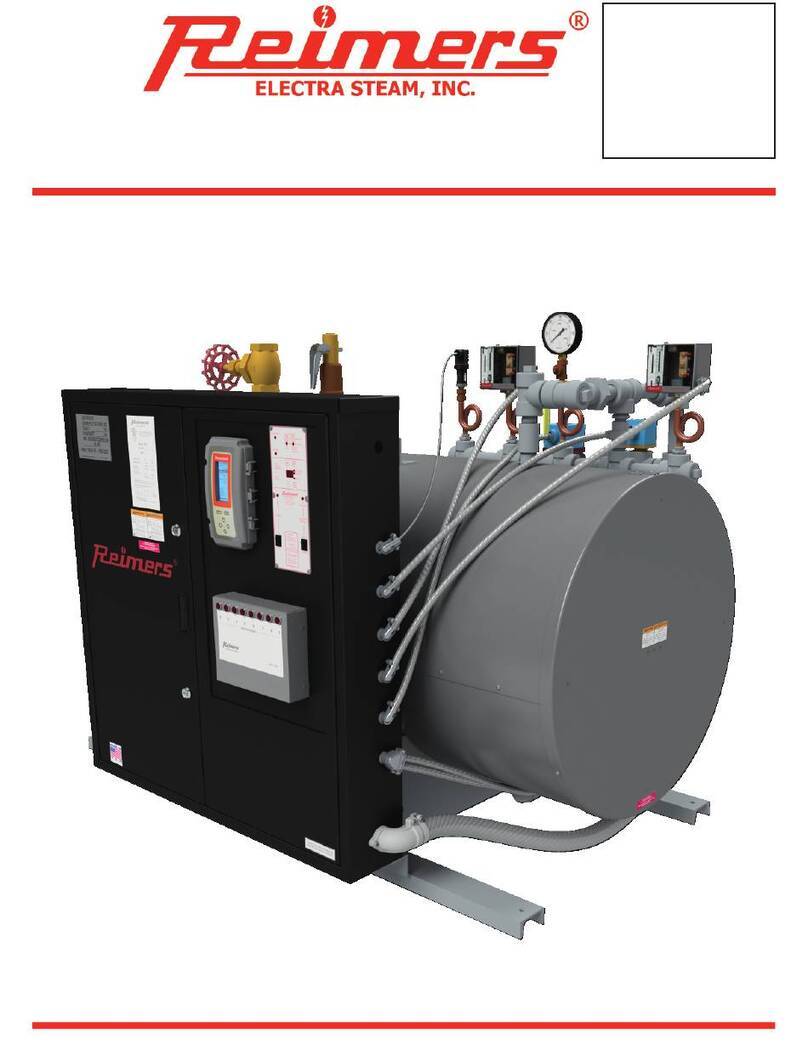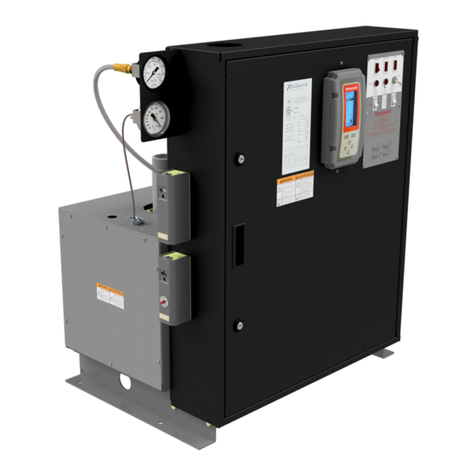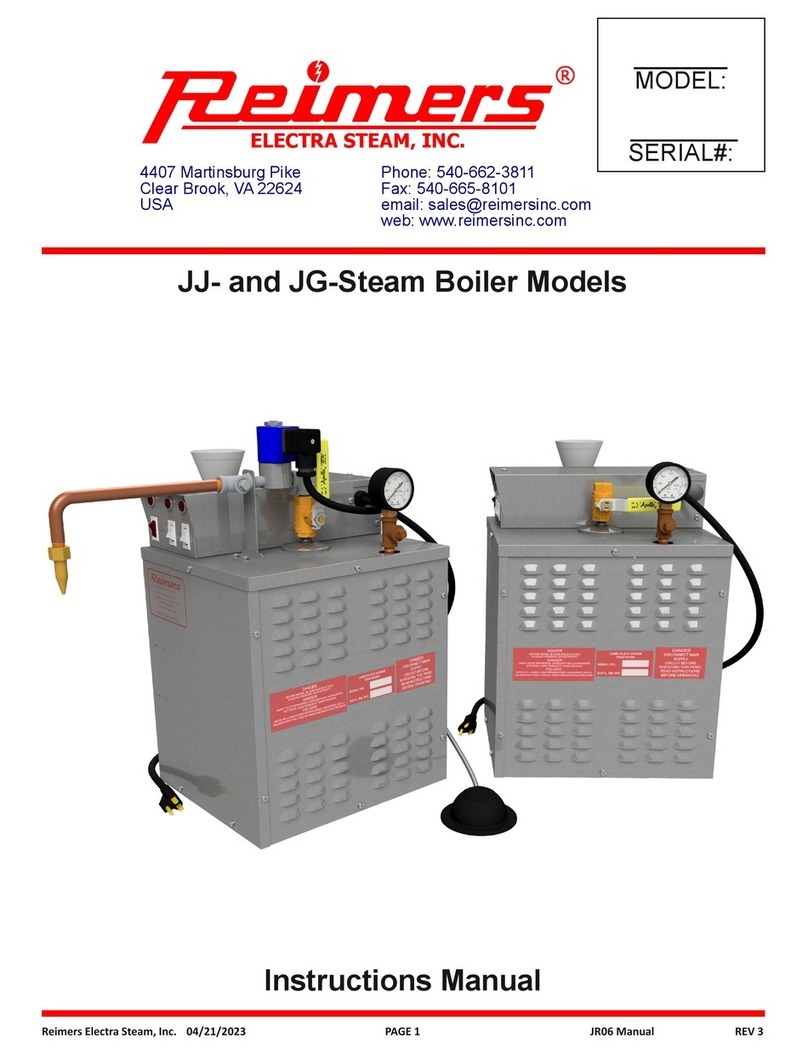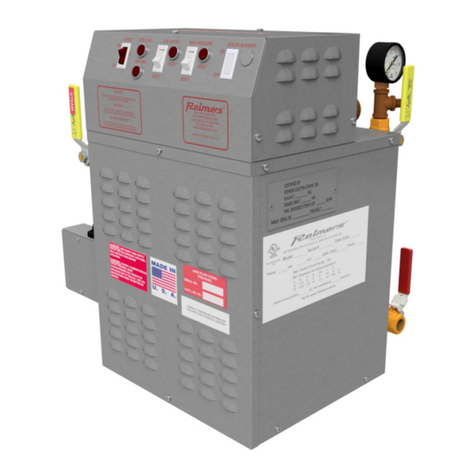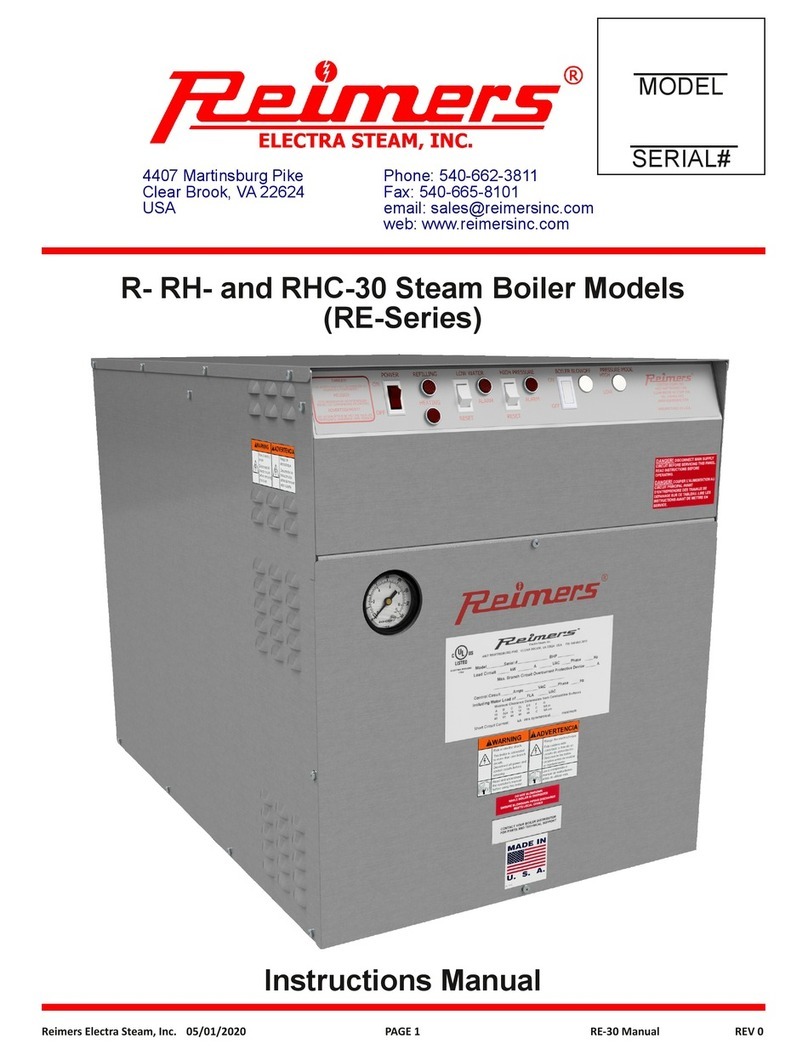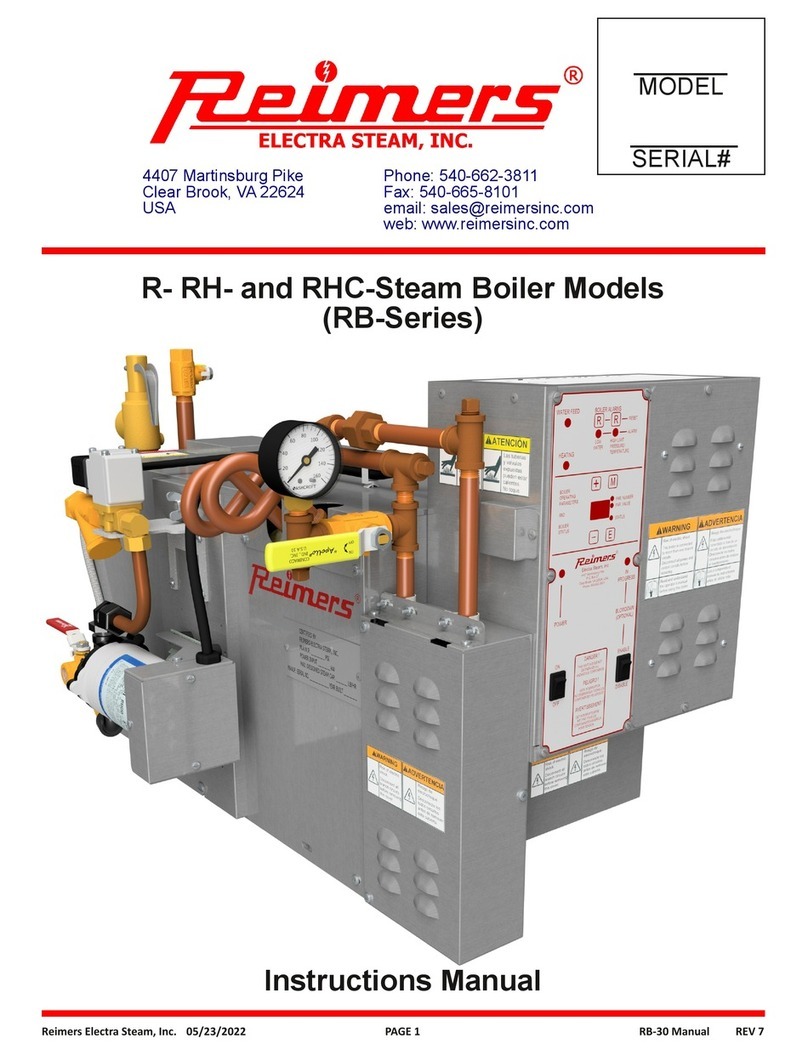
PAGE 10
Reimers Electra Steam, Inc. 3/30/2023 RHP 360‐510 Manual REV 2
The control provides four basic functions and two optional
functions. The following overview describes the functions.
Low water cutoff
High pressure cutoff
Automatic boiler refill
Automatic boiler blowoff (Optional)
The Honeywell controller T775P2003 was set at the factory
with its parameters as shown below and to the operating
steam pressure as ordered:
•Press & hold the MENU button for 5 seconds to display
the Setup Menu
•# of Sensors = 1
•Sensor A
•TYPE = 420 MA
•UNITS = PSI
•MIN VALUE = 0
•MAX VALUE = 150 (Same as Transducer)
•CALIBRATE = 0.0
•LABEL = BOILER A
•OUTPUTS
•MOD 1
•TYPE = 010V
•MIN OUT = 0
•INTEGRAL = 0
•DERIVATIVE = 0
•HIDE = NO
•Skip MOD 2, #RELAYS, OPTIONS RELAY 1, RELAY 2
•EXIT
•MENU (Press Once)
•PROGRAM ►
•MOD 1 ►
•SETPOINT = ? 150
•THROT. RANGE = 5 (Might Change) 2 PER STEP
•ACTION HEAT
Skip MOD 2, RELAY 1, RELAY 2
2.2.1 Low Water CutOff Function
The low water cutoff function of the boiler control de
energizes the heating elements when the water level in the
boiler pressure vessel falls below the minimum acceptable
operating level. The control senses the water level in the
boiler pressure vessel through a probe type control as
primary low water cutoff function with automatic reset & a
secondarey low water cutoff probe, "Probe 3". When the tip
of the probe is in contact with water in the boiler, the boiler
operates normally. When the water level in the boiler falls
below the tip of the probe the control senses that water
level is low. The control will not deenergize the heating
elements when the probe loses contact with the boiler
water for short periods of time. But, when the probe loses
contact with the probe for a set time, the control de
energizes the heating elements and turns on the “LOW
WATER” boiler alarm light. Boiler operation can only be
resumed after determining why water level is low, restoring
normal water level in the boiler and pressing the “LOW
WATER” reset button [R]. After presseing the “LOW
WATER” reset button the alarm light “LOW WATER” turns
off, the lockout is reset and the heating elements are
energized.
2.2.2 High Pressure Cutoff Function
If the operating pressure control fails, the steam pressure
in the boiler can reach the value set on the high limit
pressure control. In that case, the high limit pressure
control deenergizes the heating elements and locks them
out. The boiler alarm light “HIGH PRESSURE” comes on.
Reduce the boiler pressure to a point below the normal
operating pressure and press the high pressure reset
button [R]. Heating elements should turn on. If pressure
rises above the set operating pressure then check the
pressure transducer.
2.2.3 Automatic Boiler Refill
The probe type boiler control provides automatic boiler refill
and primary low water cutoff function with automatic reset.
When the water level drops below the water level probe,
the boiler controller energizes the feed water pump/
solenoid valve. When water comes back into contact with
the water level probe the controller turns off the feed water
pump/solenoid valve after a preset time delay. If the water
does not reach normal level within a preset time, the
controller deenergizes the feed water valve/pump and
displays a flashing “0” on the LED display. Pressing the “E”
key will start another feed water cycle.
The ON and OFF delay time can be adjusted. See the
boiler control manual for instructions.
The following are definitions for all boiler monitor
indications.
Flashing “0”: Boiler feed pump and/or solenoid remained
energized longer than the set time. Boiler feed pump and/
or solenoid are deenergized. Press “E” key to reset alarm
and start a new refilling cycle.
Flashing “1”: Following a blowdown cycle, the automatic re
fill device did not stay on for the set time. Press”E” key to
reset the alarm.
Flashing "2": Boiler is flooded. Heating and water feed are
disabled. Lower water level to resumer operation.
WARNING Boiler repairs must be performed by
experienced personnel only. Ensure boiler water is cold
and drained and that there is no pressure and all electricity
to the boiler is shutoff.
All boilers must be blown off periodically to remove
minerals, scale and other foreign matter, which accumulate
inside the pressure vessel. The concentration of this
deposit depends in part upon the condition of the water in
the area. When water is naturally soft, or has been
softened chemically, boiler blowoffs are required less often
than in areas where hard water is found. Water softeners
are suggested in hard water areas to minimize the
formation of hard scale on heating elements. Another factor
affecting water condition is the amount of condensate, if
any, that is being returned to the boiler. Since condensate
is essentially clean distilled water, it contains very few
impurities. If a large part of the condensate is being
returned and little makeup water is used, the boiler need
not be blown down as often as when little or no condensate
is returned to the boiler. We recommend blowoff of newly
installed steam boilers once per day until the first heating
element and pressure vessel inspection is performed (refer
to chapter 3.4). If no significant amount of sediment is
found on the bottom of the pressure vessel and on the
heating element sheaths, then the boiler blowoff frequency
can be reduced accordingly. The safest method to blowoff
Rseries steam boilers is to install a Reimers Electra
Steam, Inc. properly sized and fully trimmed blowdown
tank, model BTANK16. Reimers blowdown tanks are
designed and constructed to Section VIII of the A.S.M.E.
Code and inspected by a commissioned National Board
Boiler inspector.
2.2 Control Functions
2.3 Boiler Monitor Definitions
3. Boiler Maintenance
3.1 Boiler Blowoff
